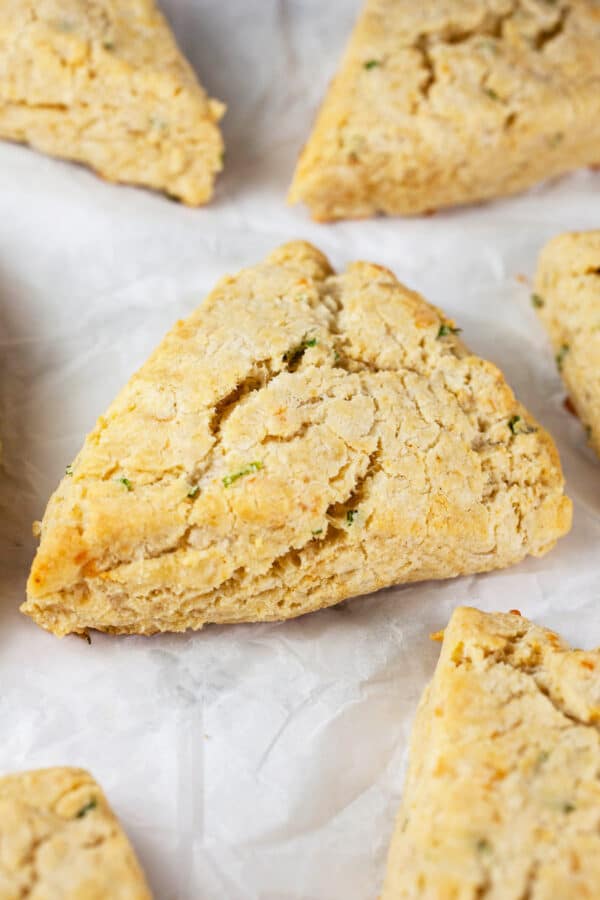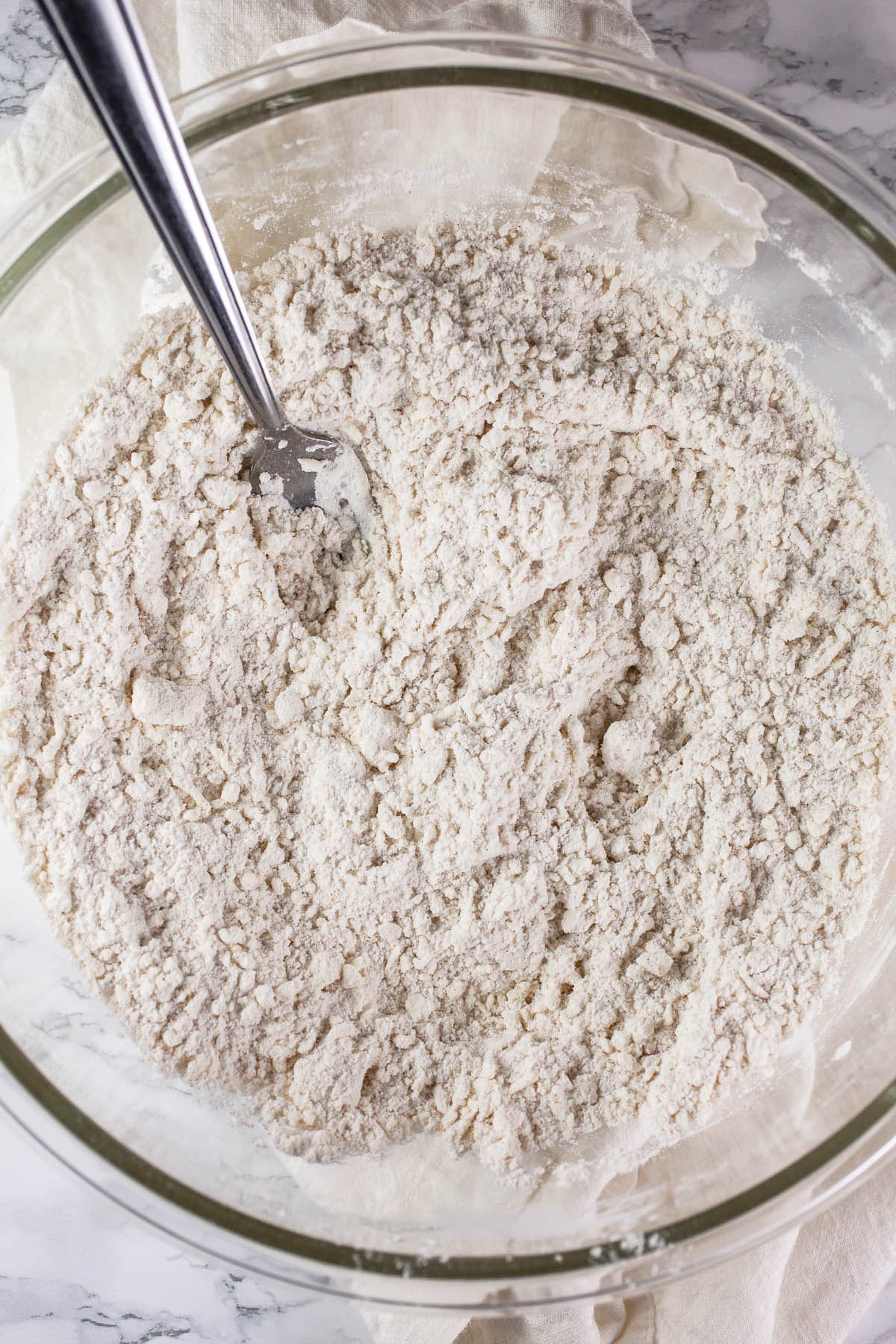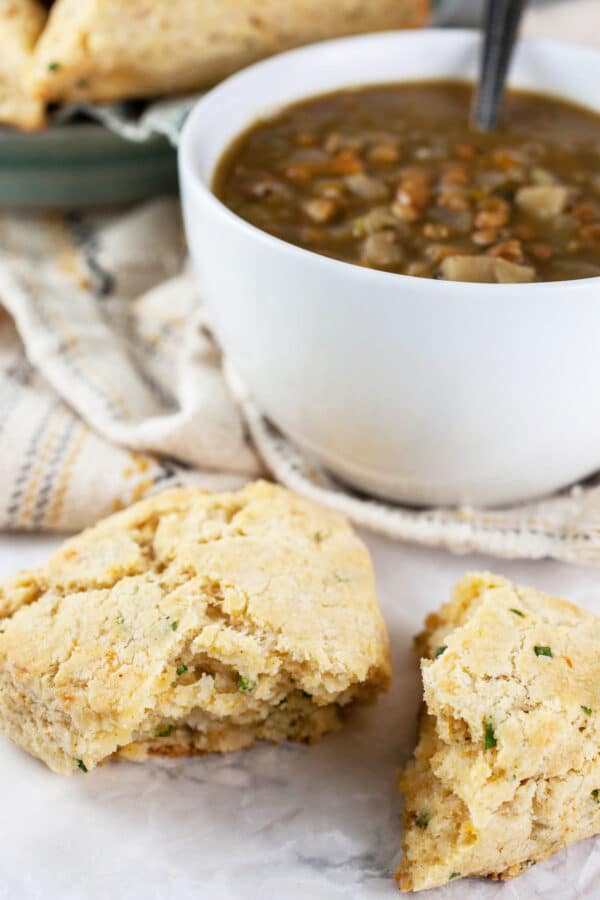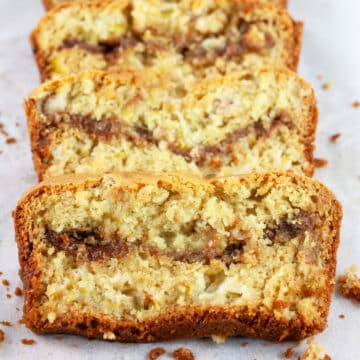These light and fluffy herb Gluten Free Cheese Scones are made with cheddar and chives. This recipe is savory and perfect served with soup!
When I think of scones, I picture something sweet that's served for breakfast with a cup of coffee or tea. It turns out, though, that savory scones are every bit as delicious as their sweeter counterparts.

The scones that I grab at my local coffee shop to enjoy with my Americano are usually something along the lines of blueberry, maple walnut, or raspberry white chocolate.
Until recently, I never thought much about the savory version of this bread-y treat. After making a batch of these Gluten Free Cheese Scones, I can see that I have been missing out.
These savory scones are made with cheddar cheese and fresh chives. They're light, fluffy, and perfect served with anything from a big bowl of soup or stew for dinner or a cup of coffee for breakfast.
Scones are a bit like biscuits and can be enjoyed as such. They're delicious served warm right out of the oven and make a great accompaniment to any meal!
Jump to:
- How Do I Get Scones To Rise and Be Fluffy?
- Ingredients For Gluten Free Cheese Scones
- How To Make Cheese Scones
- What's The Best Cheese For Scones?
- What's The Best Texture For Scone Dough?
- Why Chill Scones Before Baking?
- How Long Do Scones Take To Bake?
- What To Serve With Savory Scones?
- What To Put On Cheese Scones?
- How To Store Scones
- Can Scones Be Frozen?
- Gluten Free Cheese Scones

How Do I Get Scones To Rise and Be Fluffy?
A light and fluffy texture is the key to a good scone. Scones are much like biscuits and pie crust in this respect. It's important that a scone is not too dense, dry, or flat.
The inside of a scone should be a little soft and flaky and the exterior a bit crunchy.
Much of the texture comes from the use of butter. I find that freezing the butter and then grating it with a cheese grater helps to provide excellent texture when making scones.
Freezing the butter helps to prevent it from melting in your fingers and grating it allows for even distribution in the dough. The little pockets of butter in the dough provide that flaky texture we all know and love.
This recipe also uses eggs, baking powder, and a bit of baking soda; all of which help the dough to rise and to create a nice lift as the scones bake in the oven.
Ingredients For Gluten Free Cheese Scones
Here's what you'll need to make these savory scones.
- 2 ¼ cups Gluten Free Flour Blend (or AP flour if not gluten free)
- 1 Tbsp. Granulated Sugar
- 1 Tbsp. Baking Powder
- ½ tsp. Baking Soda
- ½ tsp. Smoked Paprika (can use regular paprika or chili powder)
- ½ tsp. Garlic Powder
- ¼ tsp. Kosher Salt
- ½ cup (1 stick) Unsalted Butter (frozen)
- 1 cup Sharp Cheddar (or Cheddar Cheese of choice)
- ¼ cup Minced Fresh Chives (or 2 Tbsp. Dried Chives) (or herb of choice)
- 2 Eggs
- 1 cup + 2 Tbsp. Heavy Whipping Cream
A Few Things
- This recipe is gluten free and uses a gluten free flour blend such as Bob's Red Mill 1 to 1 Flour or Cup 4 Cup. I have not tested the recipe using regular AP flour, but it should be just fine to use if gluten is not an issue for you.
- Feel free to substitute regular paprika or chili powder in place of smoked paprika if that's what you have on hand.
- You can use any herb you like to make these savory scones. Chives, rosemary, oregano, sage, Italian seasoning, or scallions are all great choices.
- Dried herbs may be substituted for fresh, but it's best to reduce the amount down to 1-2 Tbsp., as some dried herbs can be quite strong in flavor. You can adjust the amount of herbs (fresh or dried) to your liking.
- You can sub buttermilk for heavy whipping cream, but it might add a slightly tangy flavor to the scones.




How To Make Cheese Scones
I was always intimidated by the thought of making scones, but it turns out that the process is simple and quite enjoyable. If you can make pie crust or biscuits from scratch, scones will be no problem for you!
The process starts by separating the wet and dry ingredients and then adding the frozen, grated butter and any additional ingredients. It's much the same as making sweet scones.
- Place ½ cup (1 stick) unsalted butter in the freezer for at least 30 minutes, or until frozen.
- In a large bowl, add 2 ¼ cups gluten free flour blend (or AP flour if not gluten free), 1 Tbsp. sugar, 1 Tbsp. baking powder, ½ tsp. baking soda, ¼ tsp. kosher salt, and ½ tsp. each of smoked paprika and garlic powder. Stir until completely combined.
- In a separate bowl, add 2 eggs and 1 cup plus 2 Tbsp. heavy whipping cream. Whisk until completely combined.
- After the butter is frozen, remove it from the freezer and grate it using the fine size of a cheese grater. Make sure to exercise caution when grating the frozen butter so that you don't cut your fingers. Alternately, you can grate the frozen butter in a food processor. Simply cut the frozen butter into chunks before placing it in the food processor.
- Add the grated butter to the dry ingredients and stir until completely combined. The texture should resemble coarse crumbs.
- Grate 1 cup of sharp cheddar (or cheddar of choice) and add it to the dry ingredients.
- Mince ¼ cup fresh chives (or herbs of choice) and add it to the dry ingredients.
- Fold the cheese and herbs into the dry ingredients until combined.

What's The Best Cheese For Scones?
Cheddar is a classic choice when it comes to savory scones. Aged or sharp cheddar adds even more flavor. I used an aged white cheddar when making this recipe and found it to be perfect.
Other excellent choices include Gouda, Gruyere, or Fontina. These varieties of cheese melt nicely when baked in the oven and provide a sharp flavor to the scones.
It's best to choose a variety of cheese that is slightly dry, melts nicely, and provides enough flavor to be detectable after the scones are baked.
A creamy cheese like brie or cream cheese will provide too much moisture and alter the texture of the scones when baked in the oven.

What's The Best Texture For Scone Dough?
Once the wet and dry ingredients are ready, it's time to combine them into one bowl and then to pour the dough out onto a flat surface, form it into a round disc, and cut the disc into wedges.
The scone dough should be thick, slightly crumbly, and a bit sticky. It's not as dry and crumbly as a pie dough, but not as runny as a muffin batter.
You should be able to pick the dough up with your hands and work with it. If the dough is too crumbly, add a bit more heavy whipping cream.
If the dough is too wet and sticky, feel free to add a bit more flour.
- Add the wet ingredients to the dry a bit at a time, stirring each time. Continue until the wet and dry ingredients are completely combined and the dough has reached a thick and slightly crumbly, but sticky texture.
- Turn the dough out onto a flat, floured surface and use your hands to form it into a disc that is roughly 8 inches across.
- Press the top of the disc down with your hands, so that the surface is even.
- Cut the dough into 8 evenly sized wedges with a knife and place the wedges onto a baking sheet that has been lined with parchment paper.

Why Chill Scones Before Baking?
For the best texture, it's recommended to chill scones in the fridge before baking. This ensures that the butter stays cold, which helps the scones to rise as they bake, as opposed to spreading on the baking sheet.
Dough that spreads instead of rises will result in a flat scone and a tough texture.
Cold butter helps to create those little pockets of buttery goodness that we love in our pastries and pie crusts.
- To chill the scones, place the baking sheet in the fridge for 15-30 minutes before baking. There is not need to freeze them, just allow them to chill slightly.

How Long Do Scones Take To Bake?
After chilling, the scones are ready to bake!
- Heat the oven to 400 degrees Fahrenheit.
- Make sure there is a bit of space between each scone so that they have enough room to rise. Feel free to use two baking sheets if necessary.
- Place the baking sheet in the oven and bake for 16-17 minutes, or until the scones are lightly golden on top.
- Remove the baking sheet from the oven and allow the scones to cool slightly before serving.
Cooking times may vary when making scones.
It's best to keep an eye on them as they bake. It's important that the scones are thoroughly cooked, but not overcooked. Overcooked scones are tough and dry.
The outside should be slightly golden and a little crispy. The inside should be soft and a bit flaky.
The tops of the scones will likely crack a bit as they bake.

What To Serve With Savory Scones?
I love these savory Gluten Free Cheese Scones because they are so versatile. There is literally no wrong way to eat a scone.
As I mentioned before, they're great enjoyed on their own with a cup of coffee or tea.
I find that the savory flavors and flaky texture are perfect dipped into a bowl of homemade soup or stew.
You can serve them for breakfast or brunch with some eggs, sausage, ham, bacon, or smoked salmon.
What To Put On Cheese Scones?
I find that these scones need no toppings, but there are lots of delicious options if you'd like to take things up a notch.
Butter or an herb compound butter is a great choice.
Any type of savory spread, such as sundried tomato pesto, chutney, or pepper jelly is perfect.
Kalamata olive tapenade, roasted mushroom tapenade, or any type of spreadable sandwich topping will help take these scones to the next level.
Here are some homemade soups to serve with your scones!
- Italian White Bean Kale Soup
- Winter Root Vegetable Soup
- Roasted Carrot Soup
- Healthy Spinach Lentil Soup
- Split Pea Ham Soup
- Harvest Vegetable Soup
- Mediterranean Lentil Soup
- Creamy Potato Leek Soup

How To Store Scones
Scones are best enjoyed soon after baking, but they should last 2-3 days stored in an airtight container either on the counter top or in the refrigerator.
Be sure to allow the scones to cool completely before transferring to a container for storage.
Keep in mind that scones do dry out a bit the longer they sit.
Can Scones Be Frozen?
Yes, these Gluten Free Cheese Scones can be frozen baked or unbaked.
How To Freeze Baked Scones
- To freeze baked scones, prepare the recipe as directed.
- Allow the baked scones to cool completely and then wrap each one tightly in aluminum foil or plastic wrap.
- Place the wrapped scones in a heavy-duty plastic freezer bag, label with the date, and store up to 3 months.
- To thaw, remove the scones and allow to cool in the fridge.
How To Freeze Unbaked Scones
- Prepare the recipe as directed, but do not bake the scones.
- Place the unbaked scones in the freezer on a baking sheet for about an hour, until they harden.
- Once hardened, place them in a heavy-duty freezer bag, label with the date, and store up to 3 weeks.
- To bake, place the frozen scones on a parchment paper lined baking sheet and bake for 16-18 minutes at 400 degrees Fahrenheit.
Love scones? Check out these Pumpkin Scones with Maple Glaze!
Here are some of my favorite sweet baked goods!
- Cinnamon Streusel Rhubarb Muffins
- Gluten Free Biscuits
- Coffee Banana Bread
- Gluten Free Apple Muffins
- Sour Cream Rhubarb Bread
- Blueberry Buckle Coffee Cake
- Gluten Free Lemon Doughnuts
Looking For More Scones? Don't Miss These Recipes!
Cheesy Sausage Jalapeno Scones
Bacon Cheese Scones
Strawberry Scones
Lemon Cardamom Scones

Gluten Free Cheese Scones
Ingredients
- 2 ¼ cups gluten free flour blend or AP flour if not gluten free
- 1 tsp. granulated sugar
- 1 Tbsp. baking powder
- ½ tsp. baking soda
- ½ tsp. smoked paprika can use regular paprika or chili powder
- ½ tsp. garlic powder
- ¼ tsp. kosher salt
- ½ cup unsalted butter equals 1 stick
- 1 cup sharp cheddar grated
- ¼ cup minced chives or 2 Tbsp. dried chives or herbs of choice
- 2 eggs
- 1 cup heavy whipping cream plus 2 Tbsp.
Instructions
- Place ½ cup (1 stick) unsalted butter in the freezer for at least 30 minutes, or until frozen.
- In a large bowl, add 2 ¼ cups gluten free flour blend (or AP flour if not gluten free), 1 Tbsp. sugar, 1 Tbsp. baking powder, ½ tsp. baking soda, ¼ tsp. kosher salt, and ½ tsp. each of smoked paprika and garlic powder. Stir until completely combined.
- In a separate bowl, add 2 eggs and 1 cup plus 2 Tbsp. heavy whipping cream. Whisk until completely combined.
- After the butter is frozen, remove it from the freezer and grate it using the fine size of a cheese grater. Make sure to be careful when grating the frozen butter so that you don't cut your fingers! Alternately, you can grate the frozen butter in a food processor. Make sure to cut the frozen butter into chunks before placing it in the food processor.
- Add the grated butter to the dry ingredients and stir until completely combined. The texture should resemble coarse crumbs.
- Grate 1 cup of sharp cheddar (or cheese of choice) and add it to the dry ingredients. Mince ¼ cup fresh chives (or herbs of choice) and add it to the dry ingredients. Fold the cheese and herbs into the dry ingredients until combined.
- Add the wet ingredients to the dry a bit at a time, stirring each time. Continue until the wet and dry ingredients are completely combined and the dough has reached a thick and slightly crumbly, but sticky texture.
- Turn the dough out onto a flat, floured surface and use your hands to form it into a disc that is roughly 8 inches across. Press the top of the disc down with your hands and make sure that the surface is even.
- Cut the dough into 8 evenly sized wedges with a knife and place the wedges onto a baking sheet that has been lined with parchment paper.
- Chill the scones before baking. Place the baking sheet in the fridge for 15-30 to allow the scones to chill.
- Heat the oven to 400 degrees Fahrenheit.
- Place the baking sheet in the oven and bake for 16-17 minutes, or until the scones are lightly golden on top.
- Allow the scones to cool slightly before serving.
Notes
- Feel free to substitute regular paprika or chili powder in place of smoked paprika if that's what you have on hand.
- You can use any herb you like to make these savory scones. Chives, rosemary, oregano, sage, Italian seasoning, or scallions are all great choices.
- Dried herbs may be substituted for fresh, but it's best to reduce the amount down to 1-2 Tbsp., as some dried herbs can be quite strong in flavor. You can adjust the amount of herbs (fresh or dried) to your liking.
- You can sub buttermilk for heavy whipping cream, but it might add a slightly tangy flavor.
- Any variety of dry, sharp cheese such as aged or white cheddar, Gruyere, Gouda, or Fontina are great when making savory scones.
- If the dough feels too dry, add a bit more heavy whipping cream.
- If the dough feels to wet and sticky, add a bit more flour.






Lea ann aderhold austin tx
May I use another liquid rather than the heavy cream for someone who is lactose cautious… for example oat Almond or another type of milk … pls answer asap today because I want to bake these today to take to someone.. thank u …I love the sound of this recipe…
Thank you
Lea Ann Aderhold looking forward to hearing from you asap
Christine
Hi Lea ann - Thanks for the question! I'm not sure that oat or almond milk could be substituted for heavy cream because neither contain a high enough fat content. However, there are some nondairy or lactose free heavy cream alternatives on the market today. It looks like Silk and Country Crock both offer dairy free heavy whipping cream.
https://silk.com/plant-based-products/creamer/dairy-free-heavy-whipping-cream-alternative/
https://www.countrycrock.com/en-us/our-products/plant-cream
I have only ever made scones with heavy cream, but it looks like these would be worth a shot. Hope this helps!